GE workers in Alabama seek union

Workers at a General Electric factory in Alabama on Monday launched an effort to form a union, joining a wave of recent labor organization efforts at large national companies. Workers at the 179-employee GE Aviation plant in Auburn, Alabama, submitted union cards to the Birmingham office of the National Labor Relations Board in an organization effort with IUE-CWA. They said it is part of a national effort to organize at GE plants across the country and comes amid unionization efforts at other large companies like Amazon and Starbucks. A spokeswoman for the National Labor Relations Board confirmed the regional office received the union petition Monday. To qualify for a union election, the NLRB requires signatures from 30% of eligible voters at a specific facility. The IUE-CWA indicated that more than 50% of workers signed cards but did not provide an exact number. Two plant workers supporting the effort told The Associated Press, in interviews arranged by union supporters, that pay, the attitude of management toward workers, and benefits are among the driving concern of workers. “We need our voices to be heard,” Marcus Durrell, who has worked at the plant for seven years, said in a telephone interview. He said experienced workers at the plant earn less than workers at other GE facilities. “We want better pay, better benefits, just having a seat of the table,” Donna Rawlinson, 46, said. Rawlinson, who said she is on short-term disability while undergoing breast cancer treatments, said morale at the plant has declined over the years. “They keep pushing. They want more, but they don’t give anything,” she said. The company issued a statement in response to the filing. “GE employs more than 55,000 Americans, pays competitive wages in every community in which we operate, and has invested more than a billion dollars in our U.S. facilities since 2016, including in Auburn. We are committed to a direct relationship with our employees based on teamwork, cooperation, and actively pursuing mutually beneficial goals.. The effort at GE follows a union election at an Amazon facility in Bessemer, Alabama, the results of which are still being contested. Labor unions appear to be having a resurgence of interest after decades of decline. Just 10.3% of workers belonged to unions in 2021, down from 20.1% in 1983, according to the Bureau of Labor Statistics. Unionization campaigns have gained momentum recently, with workers launching efforts at Amazon, Starbucks, and other large companies. The Biden administration has also supported efforts to boost unionization campaigns at major employers. “GE workers in Alabama are sending a powerful message by coming together to form a union for the better pay, benefits, and job security they have earned. Across the country at giant corporations like Amazon and Starbucks, CEOs are getting a wake-up call from workers making their voices heard,” IUE-CWA Conference Board Chairman Jerry Carney said in a statement announcing the effort at the GE plant. Republished with the permission of The Associated Press.
National Labor Relations Board: Mine workers to pay Alabama coal company over $13M
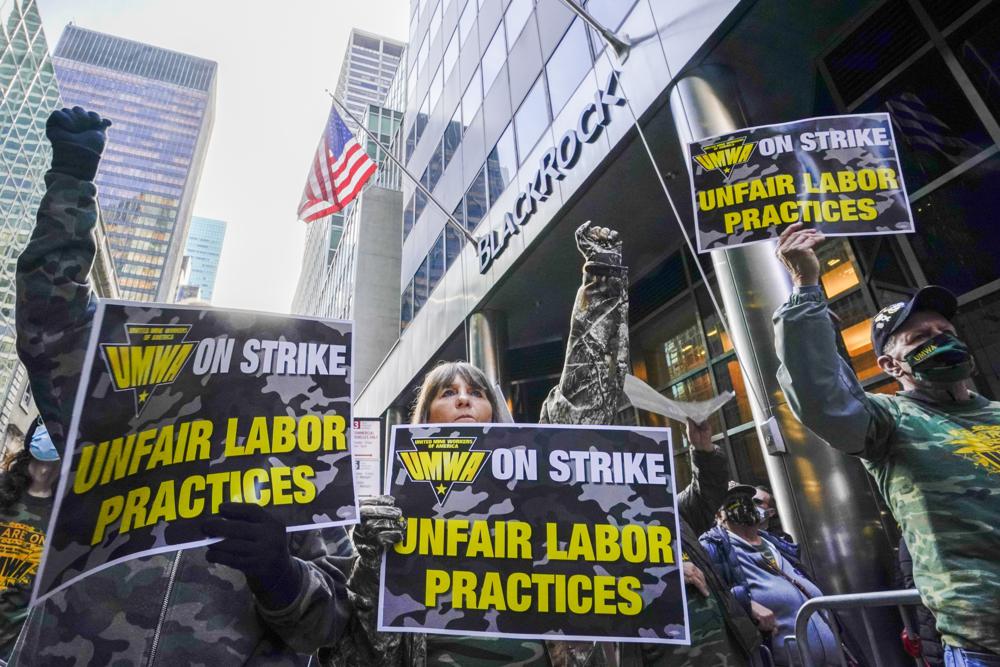
A federal oversight board ordered the United Mine Workers of America to pay more than $13 million in compensation to an Alabama coal company where members have been on strike for more than a year, a ruling the union said Wednesday it would challenge. The National Labor Relations Board said Warrior Met Coal Mining was due some $13.3 million for costs, including increased security, damage repair, and lost revenues from unmined coal, and individuals were due almost $30,000, mostly for damage to vehicles. Both amounts included interest. The union, with roughly 1,100 members who went on strike against the Alabama-based company on April 1, 2021, called the NLRB assessment an “outrageous” decision that it planned to fight. “Is it now the policy of the federal government that unions be required to pay a company’s losses as a consequence of their members exercising their rights as working people? This is outrageous and effectively negates workers’ right to strike. It cannot stand,” international union president Cecil E. Roberts said in a statement. A company representative did not immediately return an email seeking comment. The NLRB, which is handling charges related to both the company and the union, issued the order on July 22. The union and company signed an agreement providing that the union pay damages for “strike misconduct,” and the board approved it, spokeswoman Kayla Blado said. The agency is currently assessing the cost, she said. “If there is not agreement with the region’s ultimate conclusion, the region will commence a proceeding before an administrative law judge where the parties can present arguments and evidence about what each considers to be appropriate damages,” she said in a statement. Both the union and Warrior Met have blamed each other for the prolonged strike, which centers on the company’s mining operations southwest of Birmingham. The two sides have talked as recently as last week, a union spokesman said. The union is striking at Warrior Met’s No. 4 and No. 7 mines, a preparation plant, and a central shop, all in Tuscaloosa County. The union and Warrior Met reached an agreement to end the walkout a few days after it began, but members rebuffed the settlement. United Mine Workers has said union members gave up money to bring the company out of the Walter Energy bankruptcy six years ago, and workers have sought improved health benefits. Warrior Met contends it offered workers a competitive package that would protect jobs and the company’s future. In May, Warrior Met reported a net income of $146.2 million in the first quarter, compared with a loss of $21.4 million for the same period last year. The company said the strike cost it $6.7 million for the quarter because of security and other expenses and having the mines idle cost $3 million. Warrior Met said it produced 1.5 million short tons of coal in the first quarter compared with 2.2 million short tons in the first quarter last year. Republished with the permission of The Associated Press.
Starbucks in Birmingham becomes first in Alabama to unionize

A Starbucks in Birmingham has become the first in the state to unionize, WHNT reported. Workers at the 20th Street South Starbucks said the vote was 27 for, 1 against. A representative of the National Labor Relations Board (NLRB) confirmed the results. Organizers said that over 80 Starbucks locations have unionized nationwide. Kyle McGucken, a worker and organizer stated, “I am thankful to both our community and my partners for this truly historic moment. We are a beautiful family, and we wish to go forward, serving each other and our community to our best and truest values. I am proud to be with these amazing partners.” The NLRB said that the employer and workers have until June 3 to file any objections to the vote. “If neither party files objections, the results will be certified and the employer will have to bargain in good faith with the union,” a representative of the NLRB said.
Amazon staff reject union in Alabama, lean toward it in NYC

Amazon workers in Alabama appear to have rejected a union bid in a tight race, according to early results on Thursday. But outstanding challenged votes could change the outcome. In New York, union supporters have the edge in a count that will continue Friday morning. Warehouse workers in Bessemer, Alabama, voted 993 to 875 against forming a union. The National Labor Relations Board, which oversees the election, said that 416 challenged votes could potentially overturn that result. A hearing to go through the challenged ballots will occur in the next few days. Meanwhile, in a separate union election in Staten Island, New York, the nascent Amazon Labor Union is leading by more than 350 votes out of about 2,670 tallied. The close election in Bessemer marks a sharp contrast to last year when Amazon workers overwhelmingly rejected the union. “This is just the beginning, and we will continue to fight,” said Stuart Appelbaum, president of the Retail, Wholesale, and Department Store Union, which is organizing the union drive in Bessemer, at a Thursday press conference. “Regardless of the final outcome, workers have shown what is possible. They have helped ignite a movement.” Appelbaum said RWDSU will be filing objections to how Amazon handled the election but declined to be specific. He also took the opportunity to lash out at current labor laws, which he believes are rigged against unions and in favor of corporations. “It should not be so difficult to organize a union in the United States,” he said. If a majority of Amazon workers voted yes in either Bessemer or Staten Island, it would mark the first successful U.S. organizing effort in the company’s history. Organizers have faced an uphill battle against the nation’s second-largest private employer, which is making every effort to keep unions out. In New York, the ALU has led the charge to form a union along with Chris Smalls, a fired Amazon employee who now heads the fledging group. Turnout for the in-person election was unclear, but Smalls was hopeful of victory. “To be leading in Day One and be up a couple hundred against a trillion-dollar company, this is the best feeling in the world,” Smalls said after the conclusion of Thursday’s counting. While Smalls’ attention has been focused on securing victory in New York, similar efforts in Alabama also weighed heavily. “I’m not too sure what’s going in Alabama right now, but I know that the sky’s the limit if you can organize any warehouse,” he said, noting that the vote in Alabama could well end up differently. “I hope that they’re successful. I don’t know what’s going on yet, but we know we show our support and solidarity with them.” The warehouse in Staten Island employs more than 8,300 workers who pack and ship supplies to customers based mostly in the Northeast. A labor win there was considered difficult, but organizers believe their grassroots approach is more relatable to workers and could help them overcome where established unions have failed in the past. John Logan, director of Labor and Employment Studies at San Francisco State University, said the early vote counts in New York has been “shocking.” ALU has no backing from an established union and is powered by former and current warehouse workers. The group had also filed for a union election after getting support from about 30% of the facility’s workforce, a much lower percentage than what unions usually seek. “I don’t think that many people thought that the Amazon Labor Union had much of a chance of winning at all,” Logan said. “And I think we’re likely to see more of those (approaches) going forward.” Though RWDSU is currently lagging behind with challenged ballots outstanding, Logan said that the election was also remarkable because the union has made a good effort narrowing its margin from last year’s election. After a crushing defeat last year, when a majority of workers voted against forming a union, RWDSU is hoping for a different outcome in the Bessemer election, in which mail-in ballots were sent to 6,100 workers in early February. Federal labor officials scrapped the results of the first election there and ordered a re-do after ruling Amazon tainted the election process. The RWDSU said the election there had a turnout rate of about 39% this year, much smaller than last year. Appelbaum blamed the low numbers on high turnover — he believes thousands of people who worked for Amazon in January and were on the official list to be eligible to vote either quit or were fired. He also believes that an in-person election, which the RWDSU had asked for, would have made a difference. Amazon has pushed back hard in both elections. The retail giant held mandatory meetings, where workers were told unions are a bad idea. The company also launched an anti-union website targeting workers and placed English and Spanish posters across the Staten Island facility, urging them to reject the union. In Bessemer, Amazon has made some changes but still kept a controversial U.S. Postal Service mailbox that was key in the NLRB’s decision to invalidate last year’s vote. Both labor fights faced unique challenges. Alabama, for instance, is a right-to-work state that prohibits a company and a union from signing a contract that requires workers to pay dues to the union that represents them. The mostly Black workforce at the Amazon facility, which opened in 2020, mirrors the Bessemer population of more than 70% Black residents, according to the latest U.S. Census data. Pro-union workers say they want better working conditions, longer breaks, and higher wages. Regular full-time employees at the Bessemer facility earn at least $15.80 an hour, higher than the estimated $14.55 per hour on average in the city. That figure is based on an analysis of the U.S. Census Bureau’s annual median household income for Bessemer of $30,284, which could include more than one worker. The ALU said they don’t have a demographic breakdown of the warehouse workers on Staten Island, and Amazon declined to provide the information to The
Amazon workers in Alabama get a do-over in union election

The National Labor Relations Board has ordered a new union election for Amazon workers in Bessemer, Alabama, based on objections to the first vote that took place in April. The move, announced Monday, is a major blow to Amazon, which had spent about a year aggressively campaigning for warehouse workers in Bessemer to reject the union, which they ultimately did by a wide margin. The board has not yet determined the date for the second election. The rare call for a do-over was first announced Monday by the Retail, Wholesale and Department Store Union, which spearheaded the union organizing movement. In a 20-page decision, the regional director for the NLRB focused much attention on Amazon’s installation of a U.S. Postal Service mailbox at the main employee entrance, which may have created the false impression that the company was the one conducting the election process. The regional director also refuted Amazon’s position that it was making voting easier and was trying to encourage as high a turnout as possible. “The employer’s flagrant disregard for the board’s typical mail-ballot procedure compromised the authority of the board and made a free and fair election impossible,” according to the decision. “By installing a postal mailbox at the main employee entrance, the employer essentially highjacked the process and gave a strong impression that it controlled the process. This dangerous and improper message to employees destroys trust in the board’s processes and in the credibility of the election results. “ The RWDSU charged Amazon with illegal misconduct during the first vote. In August, the hearing officer at NLRB who presided over the case determined that Amazon violated labor law and recommended that the regional director set aside the results and direct another election. About 53% of the nearly 6,000 workers cast ballots during the first election. Kelly Nantel, an Amazon spokesperson, called the decision “disappointing.” “Our employees have always had the choice of whether or not to join a union, and they overwhelmingly chose not to join the RWDSU earlier this year,” she said. “It’s disappointing that the NLRB has now decided that those votes shouldn’t count.” Stuart Appelbaum, president of the RWDSU, saw the NLRB decision as a victory. “Today’s decision confirms what we were saying all along – that Amazon’s intimidation and interference prevented workers from having a fair say in whether they wanted a union in their workplace – and as the Regional Director has indicated, that is both unacceptable and illegal, “ he said in a statement. “Amazon workers deserve to have a voice at work, which can only come from a union.” But even with a second election, labor experts say a union victory is a long shot. Amazon will likely appeal and try to delay another vote. And even when an election is held, workers may choose to vote against joining a union again. Last time around, 1,798 workers rejected the union, and 738 voted in favor of it. A repeat of the election means another battle for Amazon with the RWDSU. The first election garnered nationwide attention and put a spotlight on how Amazon treats its workers. It was the biggest union push in Amazon’s history and only the second time that an organizing effort from within the company had come to a vote. Pro-union employees at the Bessemer facility said they spent 10-hour shifts on their feet in the warehouse, where online orders are packed and shipped and didn’t have enough time to take breaks. A union could force Amazon to offer more break time or higher pay, those workers said. Amazon, meanwhile, argued that it already offered more than twice the minimum wage in Alabama plus benefits without workers having to pay union dues. Amazon has been fighting two different attempts by workers to unionize in the past year. Former Amazon employee Christian Smalls is organizing an effort at a distribution center in Staten Island, New York, without the help of a national sponsor. The labor board was expected to hold a hearing to determine whether there was sufficient interest to form a union there, but less than two weeks earlier, the group led by Smalls withdrew its petition. The workers, however, can refile. Other organizing efforts are afoot beyond Amazon, including by workers at three separate Starbucks stores in and around Buffalo, New York. Meanwhile, thousands of unionized workers at Kellogg Co. remain on strike amid widespread worker unrest across the country.
Bid to unionize Amazon workers in New York nears milestone
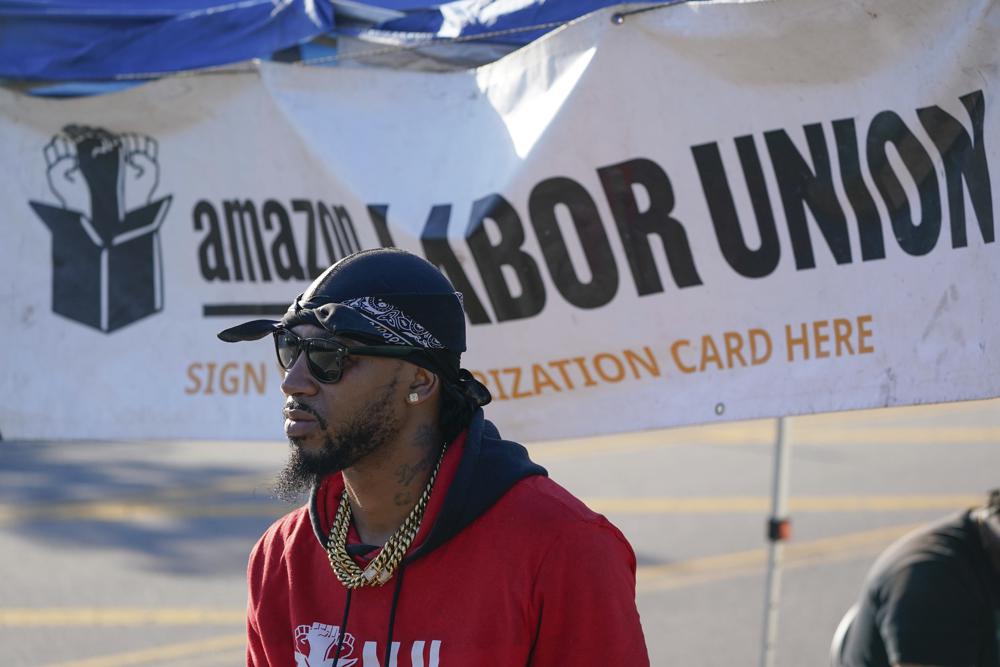
A bid to unionize Amazon workers at a distribution center in New York City neared an important milestone, as organizers prepared to deliver hundreds of signatures to the National Labor Relations Board as soon as Monday for authorization to hold a vote. Organizers say they have collected signatures from more than 2,000 employees at four Amazon facilities in Staten Island. The bid to establish the Amazon Labor Union in New York City is the second attempt in the past year to form a union at the nation’s largest online retailer. In April, workers at an Alabama facility overwhelmingly rejected forming a union in an effort led by the Retail, Wholesale and Department Store Union. The union drive in New York City is working without the help of a national sponsor and is being led by a former Amazon employee, Christian Smalls, who said he was fired just hours after he organized a walkout to protest working conditions last year at the outset of the pandemic. Organizers need to collect signatures from at least 30% of the workers — about 7,000 in four Staten Island warehouses — who would be covered by the resulting collective bargaining agreement. “We’ll have it by Monday. I’m going out there today, going out there tomorrow, the next day — until we get it,” said Smalls, who was elected Sunday as the nascent union’s president. Amazon spokesperson Kelly Nantel said the company’s employees have a choice of whether or not to join a union but “we don’t think unions are the best answer for our employees.” “Every day we empower people to find ways to improve their jobs, and when they do that we want to make those changes — quickly,” Nantel said. “That type of continuous improvement is harder to do quickly and nimbly with unions in the middle.” The union efforts in Staten Island come as Amazon is on a hiring binge. It announced in September it wants to hire 125,000 delivery and warehouse workers and is paying new recruits an average of $18 an hour in a tight job market. That’s in addition to the 150,000 seasonal workers it plans to bring on this season. The organizing drive is also happening during a moment of reckoning across Corporate America as the pandemic and ensuing labor shortage has given employees more leverage to fight for better working conditions and pay. Workers have staged strikes at Kellogg’s U.S. cereal plants as well as at Deere & Co., Frito-Lay, and Nabisco facilities nationwide. “Worker discontent goes far beyond Amazon,” said Kent Wong, the director of the UCLA Labor Center. ”Workers are feeling the pinch. They are feeling tremendous economic insecurity and they know that corporate leaders at Amazon are making record profits. There is a lot of discontent that may fuel support for this campaign.” Workers at other Amazon facilities are closely watching developments in New York City. Smalls said he’s been in discussions with other potential union organizers in about a dozen Amazon locations. Amazon employees have complained about long work hours, insufficient breaks, and safety, with Smalls and others likening working conditions to modern-day sweatshops. The employee turnover rate has also been a cause of concern. “That’s been our focus — creating a better working environment for Amazon employees,” said Derrick Palmer, another union organizer who has worked with Amazon for the past six years. “They’re working 10 to 12 hours a day and on their feet for 10 hours.” If the NLRB approves the signatures in Staten Island, it would mark the second unionization vote at an Amazon warehouse in less than a year. The first election, in Bessemer, Alabama, garnered nationwide attention and put a spotlight on how Amazon treats its workers. It was the biggest union push in Amazon’s 27-year history and only the second time that an organizing effort from within the company had come to a vote. However, there could be a do-over vote in Alabama. A hearing officer for the NLRB found in August that Amazon potentially interfered with the election. And the RWDSU is now waiting for a decision from an NLRB regional director to see whether the hearing officer’s guidance will be sanctioned. But even with a second election, labor experts say a union victory is a long shot. The unionizing effort in Staten Island differs from the one in Alabama in part because of who is leading the charge — and where. Wong noted that organizers in Staten Island face a less hostile union environment than Alabama — a right-to-work state that allows employees to decline union membership and not pay union dues. Moreover, there may be more sympathy and better response to the independent worker-run campaign that Smalls is spearheading versus the one led by the RWDSU. “There is a certain David and Goliath quality to this campaign,” Wong said. At the same time, there are downsides to going at it alone versus teaming up with a national retail labor union. “They don’t have the same staff and resources, and that makes it challenging,” Wong said of the Staten Island effort. “This is an uphill battle.” Already there is some friction starting to surface between the RWDSU and the independent effort in Staten Island. Smalls has been openly critical of national retail unions, calling them “a third party.” Stuart Applebaum, president of the RWDSU, said he takes issue with that. “Unions are not third parties, and if you listen to Chris Smalls’ logic, it calls for the elimination of all organized labor in the United States, and that is just a mistake,” Applebaum said, adding, “Amazon is such an extraordinary force with inconceivable power and wealth. You need to have an organized effort with sufficient resources.” Smalls counters: “Amazon’s been here 27 years now — if established unions were so great at organizing, wouldn’t they have done it already?” “We’re trying something different,” Smalls went on to say. “And that’s the problem that I have with everybody who expect us to just join forces with these established unions. Why can’t we lead the
Amazon union vote may spark more union pushes
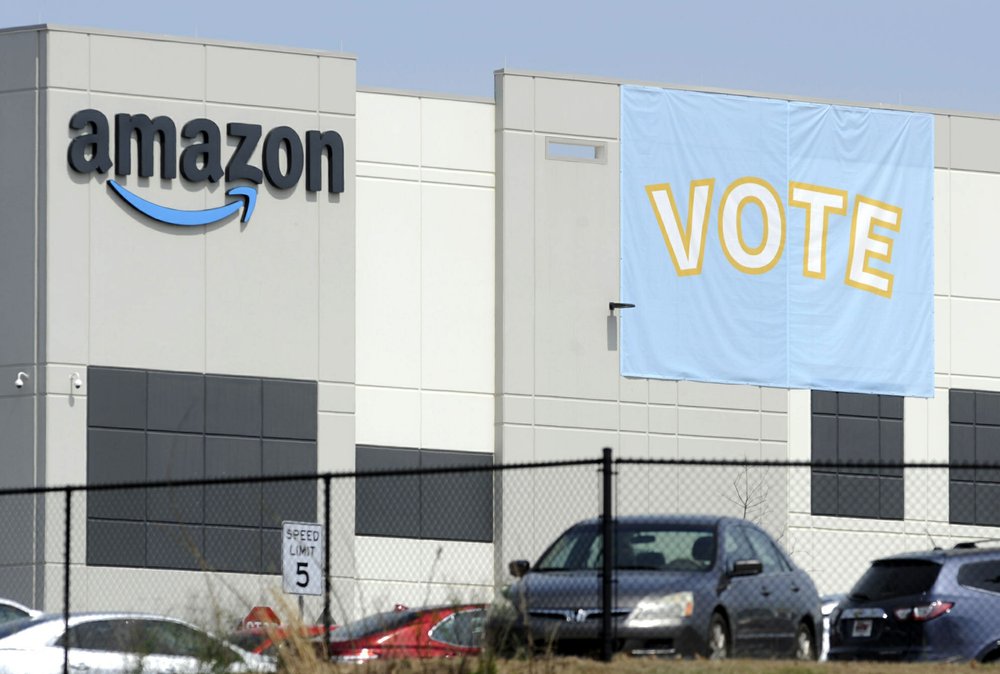
What happens inside a warehouse in Bessemer, Alabama, could have major implications not just for the country’s second-largest employer but the labor movement at large. Organizers are pushing for some 6,000 Amazon workers there to join the Retail, Wholesale and Department Store Union on the promise it will lead to better working conditions, better pay, and more respect. Amazon is pushing back, arguing that it already offers more than twice the minimum wage in Alabama and workers get such benefits as health care, vision, and dental insurance without paying union dues. The two sides are fully aware that it’s not just the Bessemer warehouse on the line. Organizers hope what happens there will inspire thousands of workers nationwide — and not just at Amazon — to consider unionizing and revive a labor movement that has been waning for decades. “This is lighting a fuse, which I believe is going to spark an explosion of union organizing across the country, regardless of the results,” says RWDSU president Stuart Appelbaum. The union push could spread to other parts of Amazon and threaten the company’s profits, which soared 84% last year to $21 billion. At a time when many companies were cutting jobs, Amazon was one of the few still hiring, bringing on board 500,000 people last year alone to keep up with a surge of online orders. Bessemer workers finished casting their votes on Monday. The counting begins on Tuesday, which could take days or longer depending on how many votes are received and how much time it takes for each side to review. The process is being overseen by the National Labor Relations Board and a majority of the votes will decide the final outcome. What that outcome will be is anyone’s guess. Appelbaum thinks workers who voted early likely rejected the union because Amazon’s messaging got to them first. He says momentum changed in March as organizers talked to more workers and heard from basketball players and high-profile elected officials, including President Joe Biden. For Amazon, which employs more than 950,000 full- and part-time workers in the U.S. and nearly 1.3 million worldwide, a union could lead to higher wages that would eat into its profits. Higher wages would also mean higher costs to get packages to shoppers’ doorsteps, which may prompt Amazon to raise prices, says Erik Gordon, a professor at the University of Michigan’s Ross School of Business. In a statement, Amazon says it encouraged all its employees to vote and that “their voices will be heard in the days ahead.” Any push to unionize is considered a long shot since labor laws tend to favor employers. Alabama itself is a “right-to-work” state, which allows workers in unionized shops to opt-out of paying union dues even as they retain the benefits and job protection negotiated by the union. Kent Wong, the director of the UCLA Labor Center, says companies in the past have closed stores, warehouses, or plants after workers have voted to unionize. “There’s a history of companies going to great lengths to avoid recognizing the union,” he says. Walmart, the nation’s largest retailer, and biggest private employer has successfully fought off organizing efforts over the years. In 2000, it got rid of butchers in 180 of its stores after they voted to form a union. Walmart said it cut the jobs because people preferred pre-packaged meat. Five years later, it closed a store in Canada where some 200 workers were close to winning a union contract. At the time, Walmart said demands from union negotiators made it impossible for the store to sustain itself. The only other time Amazon came up against a union vote was in 2014 when the majority of the 30 workers at a Delaware warehouse turned it down. This time around, Amazon has been hanging anti-union signs throughout the Bessemer warehouse, including inside bathroom stalls, and holding mandatory meetings to convince workers why the union is a bad idea, according to one worker who recently testified at a Senate hearing. It has also created a website for employees that tells them they’ll have to pay $500 in union dues a month, taking away money that could go to dinners and school supplies. Amazon’s hardball tactics extend beyond squashing union efforts. Last year, it fired a worker who organized a walkout at a New York warehouse to demand greater protection against coronavirus, saying the employee himself flouted distancing rules. When Seattle, the home of its headquarters, passed a new tax on big companies in 2018, Amazon protested by stopping construction of a new high-rise building in the city; the tax was repealed four weeks later. And in 2019, Amazon ditched plans to build a $2.5 billion headquarters for 25,000 workers in New York after pushback from progressive politicians and unions. Beyond Amazon is an anti-union culture that dominates the South. And unions have lost ground nationally for decades since their peak in the decades following World War II. In 1970, almost a third of the U.S. workforce belonged to a union. In 2020, that figure was 10.8%, according to the U.S. Bureau of Labor Statistics. Private sector workers now account for less than half of the 14.3 million union members across the country. Advocates say a victory would signal a shift in the narrative about unions, helping refute the typical arguments from companies, including Amazon, that workers can win adequate compensation and conditions by dealing with management directly. “It is because of unions that we have a five-day workweek. It is because of unions that we have safer conditions in our places of work. It is because of unions that we have benefits,” says Rep. Terri Sewell, whose congressional district includes the Amazon facility. “Workers should have the right to choose whether they organize or not.” Union leaders are circumspect about specific organizing plans after the Bessemer vote, and Appelbaum says he doesn’t want to tip off Amazon to any future efforts. But there is broad consensus that a win would spur workers at some of the 230 other Amazon warehouses to mount
Bradley Byrne: Getting results for locally owned businesses

When I ran for Congress, I made clear that I wanted to be a workhorse, not a showhorse. That means my focus has been on actually getting results instead of just talking about problems. We were able to get a big result last week when the House passed my bill, the Save Local Business Act. The legislation came about after I heard concerns from multiple locally owned businesses. I’ve sat down in local restaurants and heard firsthand from hardworking men and women who took time away from their business to travel to Washington and urge Congress to address issues caused by something known as the “joint employer” standard. So, what is the issue exactly? For decades, there was a commonsense legal test that determined when two or more separate businesses could be considered joint employers and held jointly responsible for the same group of employees. Employers had to share “direct” and “immediate” control over essential terms and conditions of employment. As a former labor and employment attorney who practiced in this area for decades, I can assure you that this was the standard that everyone knew and appreciated. Unfortunately, in 2015, the activist National Labor Relations Board (NLRB) issued a ruling in Browning-Ferris Industries that upended this cornerstone of federal labor law and created a vague and unworkable new joint employer policy. Making matters even worse and more complicated, federal agencies then incorporated the new standard in their regulatory agenda. Under this new standard, two independent businesses can be considered joint employers if they make a business agreement that “indirectly” or “potentially” impacts their employees. Just think about the uncertainty and ambiguity this standard could cause. It’s hard enough for labor attorneys to even agree on what exactly it means to have “indirect” or “potential” control over an employee. Imagine how confusing it is for Main Street businesses to understand and follow. Bob Omainsky, the owner of Wintzell’s Oyster House, had this to say about the confusion caused by the new joint-employer standard: “If we hire an outside landscaping company to keep our lawns lush, I could be considered a joint employer if I show the landscapers where to mow. Or, if I contract a food supplier for certain ingredients, I could become part of a lawsuit if one of their workers complains about overtime pay. The uncertainty is nothing more than governmental overreach that is crippling eateries like Wintzell’s and discouraging growth throughout the restaurant industry.” Workers shouldn’t have to wonder who their employer is. They deserve better than a vague and confusing rule that the American Action Forum found threatens 1.7 million jobs. Even the Progressive Policy Institute issued a statement saying that the expanded standard “may do more harm than good.” My legislation earned support from both Republicans and Democrats when it passed the House last week. This is a bipartisan issue because it isn’t about politics. Instead, it’s about saving jobs and supporting locally owned businesses. Despite scare tactics from Big Labor bosses and their trial lawyer buddies, I want to make one thing perfectly clear: this legislation does not remove a single worker protection. All worker protections provided by the National Labor Relations Act, the Fair Labor Standards Act, and the Equal Pay Act remain unchanged and are still available. Ultimately, my bill is about providing clarity to workers and job creators. It is about protecting the rights of workers and ensuring employers have clarity on their responsibilities to employees. I was proud to see the bill pass out of the House last week, and I am going to continue focusing on getting results for the people of Southwest Alabama. • • • Bradley Byrne is a member of U.S. Congress representing Alabama’s 1st Congressional District.
House passes Bradley Byrne’s Save Local Business Act

The U.S. House of Representation on Tuesday passed the Save Local Business Act, a bill that rolls back a vague and expansive Obama-era National Labor Relations Board’s (NLRB) ruling that made businesses potentially liable for labor law violations committed by their subcontractors providing certainty for local businesses and their employees. Introduced in July by Alabama 1st District U.S. Rep. Bradley Byrne, who serves as the chairman of the House Workforce Protections Subcommittee, the bill passed by a bipartisan vote of 242 to 181. “For a few years now, I’ve visited local businesses and heard concerns about how the joint employer scheme creates confusion and uncertainty for workers and job creators. With this vote today, the House has shown we are listening to those concerns and doubling down on our commitment to protecting local businesses and their employees,” said Byrne. “As someone who practiced law in this field for years, I have no doubt today’s vote will make things easier for small businesses throughout the country and help clear the air of uncertainty. I want to thank all of my colleagues for their support in passing this critical legislation, and I am especially pleased the bill passed with votes from both sides of the aisle.” Byrne’s bill amends the National Labor Relations Act and the Fair Labor Standards Act to clarify that two or more employers must have “actual, direct, and immediate” control over employees to be considered joint employers. “Today’s House vote is a victory for America’s workers and local businesses that need relief from the NLRB’s extreme and unworkable joint employer scheme. We want to make it easier, not harder, for hardworking men and women to own a business and achieve the American Dream, and that’s exactly what this commonsense bill is all about.,” North Carolina-Republican and House Education and the Workforce Committee Chairwoman Virginia Foxx said of the bill’s passage. “I want to thank Representative Byrne for championing this proposal, as well as all the members of the committee for their hard work and passion that went into advancing this important legislation.” The bill earned support from multiple national organizations, including the Coalition to Save Local Business, the U.S. Chamber of Commerce, the International Franchise Association, the National Taxpayers Union, the National Retail Federation, the Workplace Fairness Institute, the American Hotel and Lodging Association, the National Restaurant Association, and more. Byrne delivered a speech on the House floor in support of his legislation. Watch: A transcript of his speech can be found below. Mr. Speaker, today is a big day. Today is an opportunity for the House to stand up for our nation’s workers and to protect the small, local businesses which form the backbone of the American economy. Today is about restoring decades’ old labor law. Ultimately today is about giving clarity to workers and job creators all across our country. I heard from my friends across the aisle that someone can be an employee without there being an employer. I call that the immaculately conceived employee. There is no such thing under the law nor has there ever been. This bill does not change the definition of employer. It simply takes the definition of joint employer back to the way it was a few years ago. It’s a shame we even have to have this bill. But the activist National Labor Relations Board in 2015 issued a decision that fundamentally up-ended labor law as we knew it. This change didn’t come through the democratically elected Congress but instead from a panel of unelected bureaucrats. The NLRB’s decision has caused deep uncertainty among job creators. For workers, they are left to wonder who their boss really is. That is an incredibly confusing situation to be in. Under the new joint employer standard, what does it mean to have ‘indirect’ or ‘potential’ control over an employee? I practiced labor and employment law for decades, and I do not know what that means so I can only imagine the confusion Main Street businesses have faced due to this standard. Currently there are at least nine different legal tests nationwide to determine joint employer status under the Fair Labor Standards Act and more to come. This patchwork of standards creates regulatory uncertainty, especially for job creators doing business in multiple states. So despite what some on the other side want to believe, this is not an abstract issue. I have visited numerous local businesses in my district, and I know they are very worried about this scheme. I’ve heard from workers who want to remain an employee of a locally owned business with an owner who knows them instead of becoming just another employee in some large corporation. Clearly, I’m not the only one who heard these concerns. This legislation is co-sponsored by 123 of my colleagues, including members from both sides of the aisle. This is a bipartisan issue because it isn’t about politics. Instead, it’s about saving jobs and supporting locally owned businesses. And let me make something crystal clear: this bill does not remove a single protection for today’s workforce. Despite the scare tactics being used by Big Labor bosses and their trial lawyer friends, the same important protections exist under this legislation and any irresponsible employer can be held accountable. So, Mr. Speaker, I urge all of my colleagues to take the side of our locally owned businesses, to take the side of our small business job creators, and to take the side of America’s workers. Let’s stand end the confusion, and let’s pass the Save Local Business Act. I yield back my time.
Bob Omainsky: Alabama’s Bradley Byrne champions critical joint employer fix
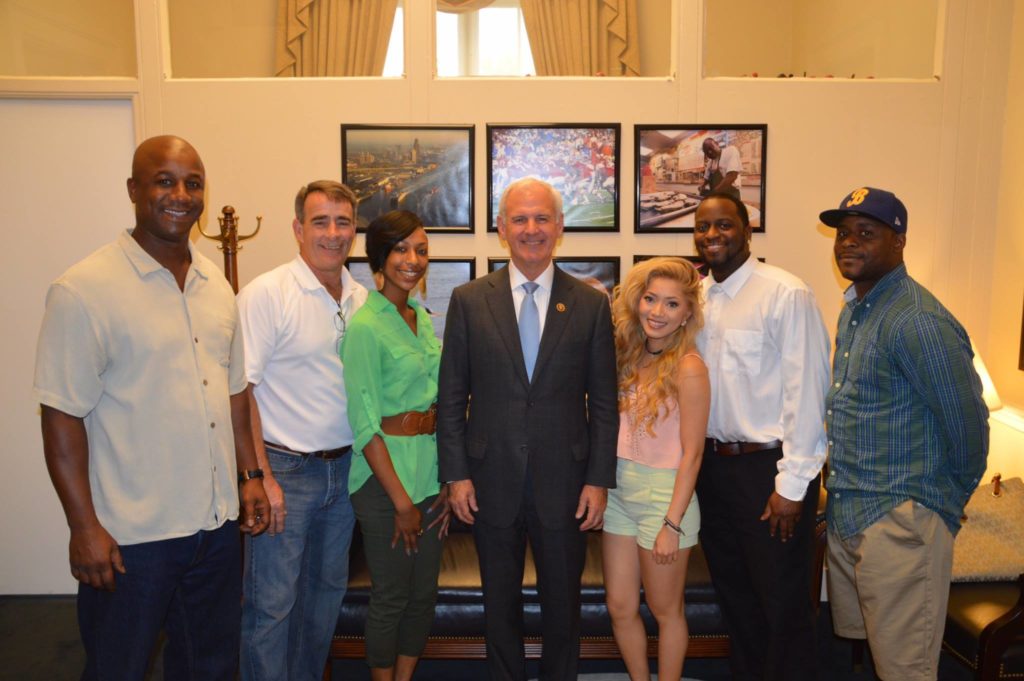
In the South, we love football, family, and food — especially here in Alabama where we have one of the most decorated football teams in the country, family gatherings are our favorite time of the week, and our food is tasty and soulful. There is no better way to bring football, family, and food together than at your favorite local restaurant. Our restaurants are as spirited and rich as our traditions. Some have been in families and communities for generations while others have developed from new and fresh ideas. But one thing that each has in common is the vital role they play in our economy. Restaurants contribute to job creation and economic growth while providing essential workforce development opportunities. They’re where employees build skills that shape their future success. They serve as pillars within their communities and are a driving force not just for Alabama’s economy, but for the nation’s economy. Alabama has 7,845 eating and drinking locations that employ 185,300 people and contribute $8.1 billion in economic output. I find it troubling that any national policy would aim to hinder, or even eliminate, the industry’s growth potential. Unfortunately, a National Labor Relations Board (NLRB) decision to expand the joint employer definition did just that in 2015. Joint employer is the standard by which two or more businesses share control of an employee. Before 2015, business owners had a clear understanding of when they might be liable for another company’s employment actions. The long-established standard held that you must have “direct” and “immediate” control over another company’s workers. Under the new rule, it’s not as simple. Today’s definition is drastically-expanded, putting restaurants at legal risk with only the vaguely defined “indirect” or “potential” control over another company’s employees. Neither attorneys nor human resources professionals can agree on the scope of these terms — leaving business owners with little recourse but to buy more expensive and protective insurance and to reevaluate many of their business relationships altogether. Take, for instance, my nearly 80-year-old business, Wintzell’s Oyster House. If we hire an outside landscaping company to keep our lawns lush, I could be considered a joint employer if I show the landscapers where to mow. Or, if I contract a food supplier for certain ingredients, I could become part of a lawsuit if one of their workers complains about overtime pay. The uncertainty is nothing more than governmental overreach that is crippling eateries like Wintzell’s and discouraging growth throughout the restaurant industry. Thankfully, Alabama’s own Rep. Bradley Byrne has introduced bipartisan legislation that aims to roll back this confusing joint employer ruling and provide some much-needed clarity for millions of restaurants across America. Rep. Byrne and the more than 50 co-sponsors of H.R. 3441, the Save Local Business Act, understand the importance of having federal policies that help businesses grow and thrive for the good of our entire workforce. On behalf of the 1,117 restaurants in Alabama’s 1st District that employ 22,259 men and women, I would like to thank Rep. Byrne for his continued leadership and his effort to clarify the joint employer issue. This is a critical measure because after all, a stable employer environment will only make our restaurants that much better at bringing together football, family, and food for generations to come. ••• Bob Omainsky is owner-operator of Wintzell’s Oyster House, with three locations in the Mobile, Ala. area.
Bradley Byrne introduces bill to protect businesses, reverse controversial labor rule
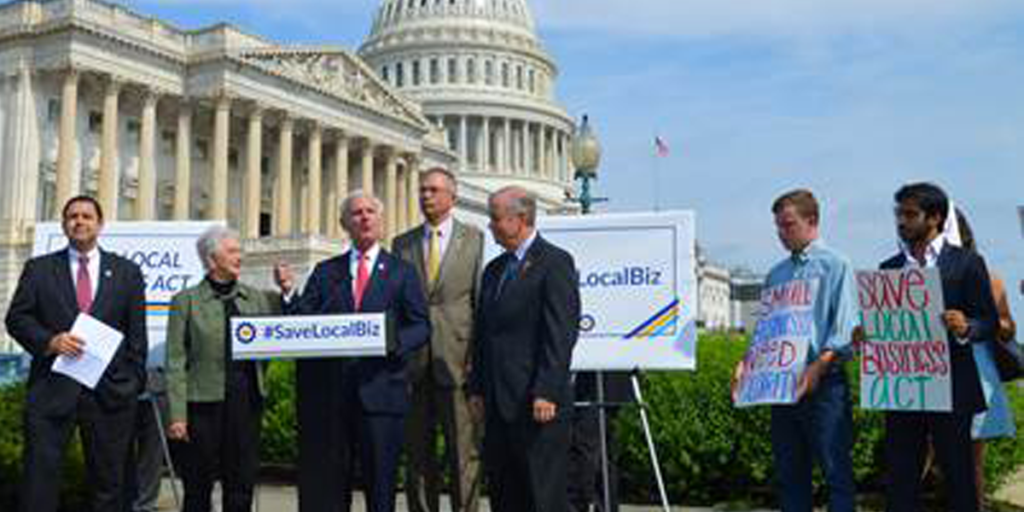
Alabama 1st District U.S. Rep. Bradley Byrne introduced legislation Thursday to protect America’s local businesses by restoring the commonsense definition of what it means to be an employer, protecting companies from being held liable for labor law violations made by their subcontractors. H.R. 3441: The Save Local Business Act, endeavors to undo an Obama-era standard in which the National Labor Relations Board (NLRB) expanded the joint employer standard and thus increased businesses’ exposure to lawsuits and unionization efforts. Byrne’s bill would amend the National Labor Relations Act and the Fair Labor Standards Act to clarify that two or more employers must have “actual, direct, and immediate” control over employees to be considered joint employers. It would: Roll back a convoluted joint employer scheme that threatens job creation and undermines the American Dream. Restore a commonsense definition of employer to provide certainty and stability for workers and employers. Protect workers and local employers from future overreach by unelected bureaucrats and activist judges. “Federal labor policies should be focused on benefiting workers and helping small businesses grow instead of creating barriers that limit opportunity. Also important, Congress – not unelected federal bureaucrats – should set our nation’s labor policies through statute instead of executive fiat,” said Byrne. “Under this bipartisan legislation, workers, and the businesses they work for, will be given much needed clarity and certainty. I am especially pleased our legislation has earned support from both sides of the aisle, and I am committed to continuing to build momentum as the bill moves through the legislative process.” The bill has bipartisan support from 29 co-sponsors, including House Education and the Workforce Committee Chairwoman, North Carolina Republican Rep. Virginia Foxx. “Right now, local employers across the country face an enormous amount of uncertainty because of a vague and confusing joint employer standard,” commented Foxx. “Congress cannot sit on the sidelines while this harmful scheme threatens to destroy jobs and make it harder for entrepreneurs to achieve the American Dream of owning a business. I commend Congressman Byrne for his leadership in this bipartisan effort to protect jobs and the spirit of entrepreneurship in local communities.”
Bradley Byrne: The 21st century workforce

A lot has changed since the 1930s. For example, in 1938, Franklin Roosevelt was President, and you could buy a loaf of bread for ten cents. Since then, the Internet was invented, more jobs are based in technology, and almost every American has a cell phone. Sadly, some of our nation’s most important labor laws, like the Fair Labor Standards Act, date back to the 1930s. One could argue that the needs of the workforce have changed a lot in just the last decade, but they have most certainly changed over the last eighty years. Clearly, something is still holding our economy back. Since 2009, the economy has grown at an average annual pace of just 1.5 percent. Wage growth remains largely stagnant, as the average hourly earnings for today’s worker is roughly the same as they were in 2009. Meanwhile, 7.6 million Americans are searching for work, and nearly six million individuals are working part-time hours when they really want full-time jobs. Our outdated labor laws and policies play a significant factor in limiting economic growth, and it is time we examine how to reform these important laws to allow for more flexibility for workers in the 21st Century. This is a topic I covered last week in my first hearing as Chairman of the House Subcommittee on Workforce Protections. The American workforce has transformed dramatically since some of our labor laws were passed, and the challenges facing workers and employers today are substantially different than they were in the 1930s. However, our labor policies have failed to adapt. Our confusing and outdated labor policies are especially harmful to small businesses. Big businesses and large corporations often have entire divisions and lawyers set aside to figure out how to comply with rules and regulations. Smaller businesses, which make up the overwhelming majority of our economy in Southwest Alabama, do not have the same resources. When small businesses suffer, American workers suffer. It is clear our nation’s labor rules were designed for another era and no longer reflect the realities of the 21st Century workforce. That’s why it is so disappointing the Obama Administration missed an opportunity to streamline and modernize these important worker protections. Instead, the previous administration spent its time and resources advancing an extreme and partisan agenda that would stifled workplace flexibility and limited opportunities for career advancement. We must do better. Thankfully, we are in a new era now, and I am optimistic the Trump Administration will pursue policies that benefit American workers. Just last week, President Trump announced his nomination of Alexander Acosta to serve as Secretary of Labor. From his time on the National Labor Relations Board to his service as a U.S. Attorney, Mr. Acosta has a clear record of protecting American workers and upholding the law. As Chairman of the Workforce Protections Subcommittee, I am committed to working with Mr. Acosta to find solutions to update our labor and workplace laws and help bring them into the 21st Century. Just as important, I want to find ways to eliminate confusion and uncertainty that make it harder for small businesses to grow and expand. We cannot accept the economic struggles of the last few years as the new normal. The American people have clearly spoken, and they expect their leaders in Washington to put the country on a better path and finally get the economy moving again, which means more and better paying jobs. That is a top priority for me and our unified Republican government. I look forward to making a positive impact on behalf workers in Southwest Alabama and across the country. • • • Bradley Byrne is a member of U.S. Congress representing Alabama’s 1st Congressional District.


